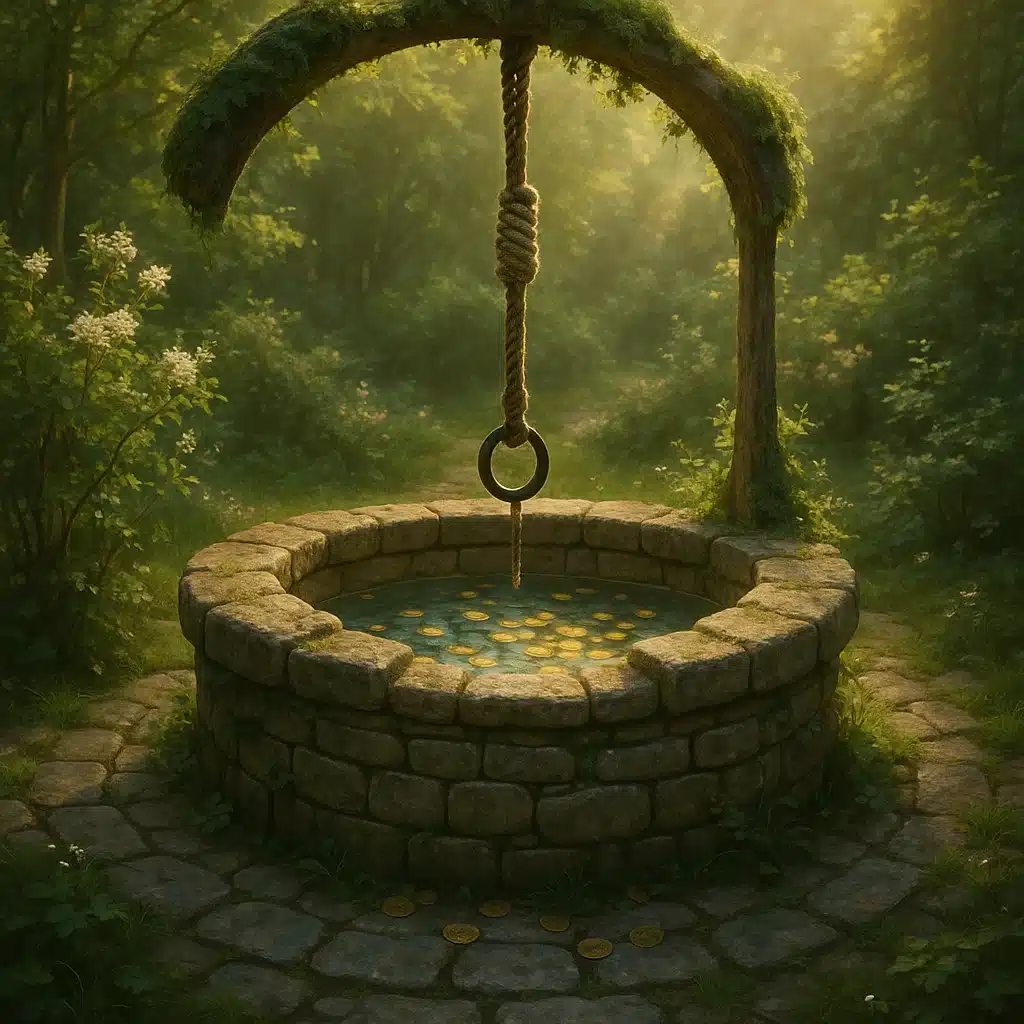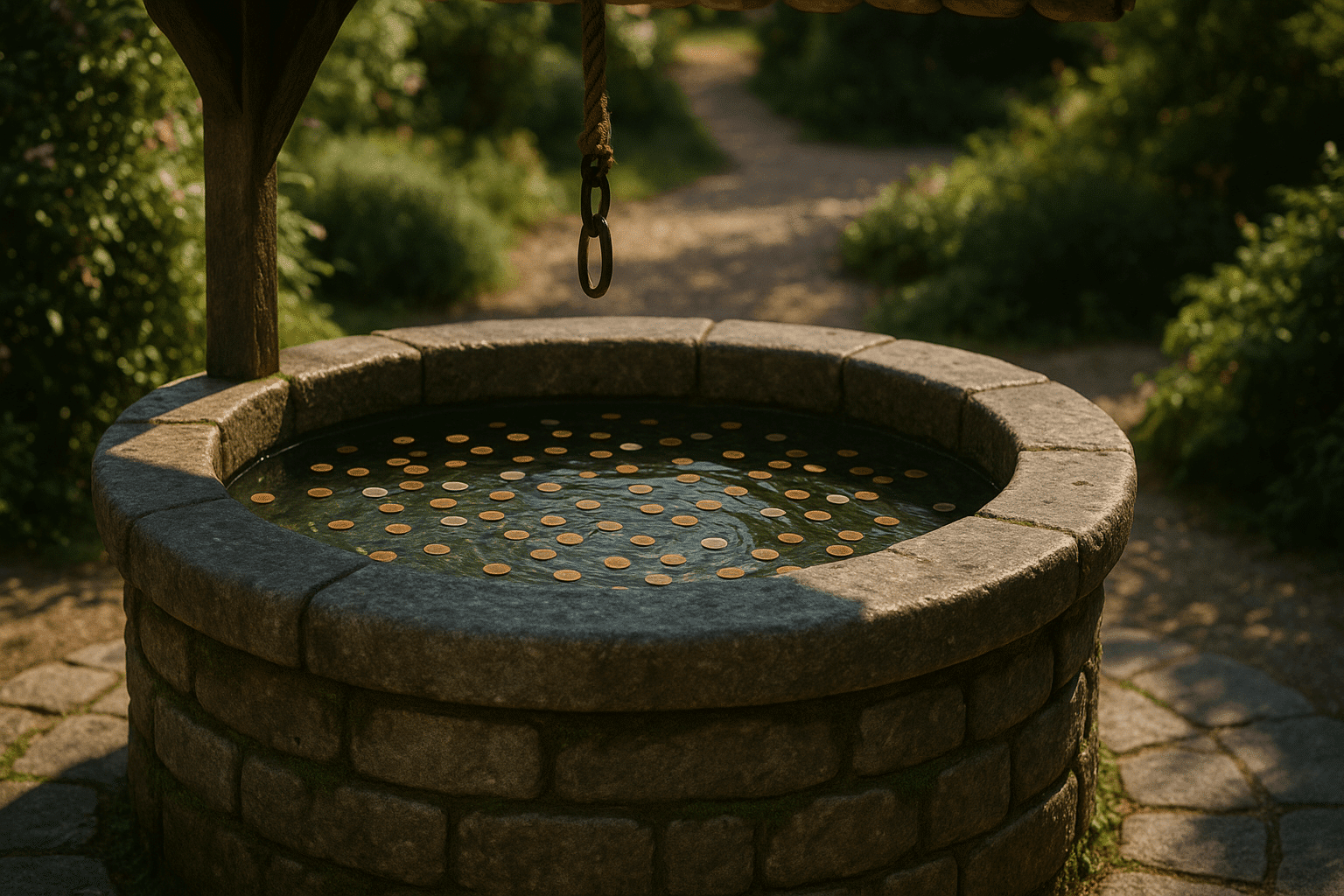Introduction: A Small Coin, a Big Wish
There’s something oddly satisfying about tossing a coin into a fountain or well. The moment your fingertips release it, you watch it arc through the air, hit the water, and disappear beneath the ripples. Whether in a bustling city square or a quiet countryside spring, the act feels almost instinctual, as if you’ve tapped into something timeless.
But why do we do it? Is it just tradition, a harmless superstition, or something more deeply rooted in our psychology and shared human history? The truth is, the act of throwing coins into water, be it a well, fountain, or river, is layered with ancient beliefs, myths, and subconscious motivations that span centuries and cultures.
In this deep dive, we’ll explore:
- The historical origins of wishing wells and coin-tossing
- Myths and legends that shaped the tradition
- The psychology and symbolism behind the act
- How modern culture continues (and transforms) this ritual
- Ancient Beginnings: Water as a Sacred Resource
Long before coins existed, fresh water sources were regarded with deep reverence. Springs, rivers, and wells were lifelines for communities, making them sacred in many cultures. Ancient societies often viewed natural water as a gift from the gods, pure, life-giving, and imbued with spiritual energy.
Celtic Sacred Springs
In Celtic Europe, springs and wells were believed to be inhabited by deities or guardian spirits. Offerings, often jewelry, weapons, or other valuables, were placed in these waters to gain the favor of these supernatural beings. Archaeological excavations at sites such as Bath in England (once a Celtic and Roman sacred site) have uncovered hundreds of coins and offerings from centuries ago.
Roman Influence
When the Romans arrived in Celtic territories, they brought their own water-related deities and rituals. They adopted and adapted local traditions, making the act of tossing coins or trinkets into water a formalized practice tied to divine petitioning.
Norse Mythology
In Norse legend, Mímir’s well was a source of wisdom. Odin, chief of the gods, sacrificed one of his eyes into the well to gain knowledge — a myth that parallels the idea of giving up something valuable for a greater benefit.
The Birth of the Wishing Well
The concept of a “wishing well” as we know it — a man-made structure protecting a water source, often accompanied by a tradition of coin tossing — evolved during the medieval period in Europe.
Practical Meets Mystical
Wells were covered to keep them clean, and often a decorative structure was built around them. People began to believe that speaking a wish into the well, accompanied by a small offering, could make it come true. The coin served as a symbolic gift to the well’s guardian spirit.
The Whisper of Wishes
One superstition held that you should whisper your wish into the water so the spirit could hear it, and the act of throwing in the coin sealed the request. The sound of the coin hitting the water was thought to catch the spirit’s attention.
Myths and Legends: Storytelling that Shaped the Ritual
Many regional myths added layers of meaning to the tradition of tossing coins into wells.
German Folklore
In some German tales, wells were gateways to other realms, including the land of the “Well Maiden” or water nymphs who could grant favors. Offering a coin was both payment and a sign of respect.
Greek and Roman Legends
The gods and goddesses associated with water, such as the Greek Naiads or Roman Nymphs, were believed to reward those who honored them. The offering was a transaction: “I give you this, you give me luck or love in return.”
“Make a Wish Before It Sinks”
In some traditions, the wish had to be made and completed before the coin touched the water’s surface, a race against gravity that added a playful challenge to the ritual.
The Psychology Behind Tossing Coins
Beyond mythology, modern psychology offers insight into why the tradition persists.
1. The Power of Symbolic Exchange
Humans are naturally inclined toward reciprocity. When we want something, good luck, love, success, we often feel compelled to give something in return. A coin, however small, represents an offering in exchange for hope.
2. The Illusion of Control
Life is unpredictable, and wishing rituals give us a sense of agency. Even if we rationally know tossing a coin won’t influence fate, the act can reduce anxiety and foster optimism.
3. Anchoring Our Intentions
Throwing a coin is a physical action that “anchors” a thought or wish in our minds. This aligns with psychological theories of intention-setting: physical gestures help solidify mental goals.
4. The Reward of Tradition
Participating in a long-standing tradition connects us to history, culture, and community. There’s comfort in doing something millions before us have done.

Cultural Variations: Coins, Fountains, and Beyond
While Western culture often focuses on fountains and wells, other societies have similar traditions with unique twists.
Japan: Temples and Shrines
At Shinto shrines, visitors toss coins into offering boxes before praying. The most common coin is the five-yen piece, considered lucky because its Japanese pronunciation (“go-en”) sounds like the word for “good fortune” or “destiny.”
Thailand: Temple Ponds
Some Buddhist temples feature ponds or small fountains where visitors toss coins as an act of merit-making, combining spiritual devotion with charitable giving.
Italy: The Trevi Fountain
Rome’s Trevi Fountain may be the most famous coin-tossing site in the world. Legend says tossing one coin ensures a return to Rome, two coins bring love, and three coins lead to marriage. The coins are collected daily and donated to charity.
From Sacred Ritual to Tourist Attraction
Today, wishing wells and water fountains are as much about tourism as they are about tradition. Parks, gardens, and city centers worldwide feature fountains designed to attract both sightseers and coin tossers.
The Economics of Wishes
Many public fountains collect hundreds, even thousands, of dollars in coins annually, which are often donated to charitable causes. This modern twist keeps the tradition alive while serving a social good.
The Symbolism of Water and Wealth
- Two powerful symbols intersect in this tradition: water and money.
- Water represents life, renewal, and transformation.
- Coins symbolize value, wealth, and exchange.
Together, they create a ritual that blends hope for abundance with the timeless allure of water’s mystery.
Are We Hardwired to Keep Doing This?
Psychologists and anthropologists suggest that the coin-tossing tradition is unlikely to disappear. It’s simple, it’s symbolic, and it taps into deep emotional and cultural layers, from ancient offerings to modern travel habits.
Even in an increasingly digital age, where physical currency is fading, people still find ways to make symbolic offerings, whether tossing digital coins in virtual games or dropping tokens in charity fountains.
Final Thoughts: More Than Just a Coin in the Water
When you next find yourself by a fountain or wishing well, remember that your small gesture carries centuries of history and meaning. You’re not just tossing a coin, you’re participating in a global ritual that has connected people through myth, hope, and shared humanity for millennia.






